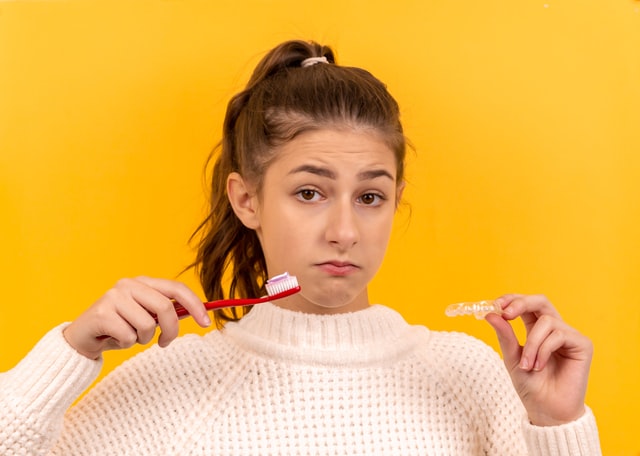Purchase the appropriate toothbrush. When there’s so many alternatives, picking a toothbrush can be difficult. The majority of us like medium and stiff brushes because we believe they provide a better clean. Actually, since they are abrasive on the teeth and gums, they may be doing more damage than good. Soft brushes, when used properly and on a regular basis, are effective in removing plaque without harming the gums.
- Buy a protective toothpaste. The toothpaste you use is an essential part of your routine as well. Choose one with fluoride, since this is particularly beneficial for maintaining strong and healthy teeth. To keep your teeth appearing white, you don’t require whitening toothpaste. These may be overly abrasive, causing your teeth’s look and function to deteriorate in the long term. Remember that tooth colour fluctuation isn’t necessarily a sign of bad health! Some folks may choose for a toothpaste that is gentler on their gums.
- Make sure to get every angle. By using a brush with a smaller head, you’ll be able to reach every aspect of your mouth. Remember to brush your back teeth, the backs of all your teeth, and the nooks and crevices between your teeth. Massage plaque and debris away from all of your teeth in circular movements for several minutes.
- When cleaning our teeth, many of us forget to pay attention to the teeth and gums.
- Flossing isn’t everyone’s favourite chore, but it’s crucial. Plaque, tooth decay, and gum disease may all be caused by material caught between the teeth, which can be removed using dental floss. It’s important to floss before cleaning your teeth, something you may not be aware of. This guarantees that all dental debris is brushed or washed away.
- It’s recommended to use mouthwash to completely remove dirt and plaque, reduce bacteria development, and refresh breath. Look for antibacterial characteristics, but don’t be fooled by promises of whitening or enamel repair.
- Consider an electric toothbrush. Although an electric toothbrush isn’t required, it might assist in achieving a thorough cleaning. At least initially, you’ll notice a change in your teeth’s smoothness. You don’t need a brush with a lot of bells and whistles; a simple oscillating head will do. If you can afford it, we suggest a model with this feature.
- Don’t overdo it, we would suggest caution, as much as it is necessary to brush your teeth completely and consistently. Don’t be too strict, but be diligent. Your teeth are tough and durable, but brushing too hard may wear off tooth enamel. Gums are supposed to be handled with caution, so take it easy if you’re in discomfort or bleeding. Don’t be tempted to make up for previous faults in the future by going all out. If someone forget to brush your teeth, don’t worry.
Cavity Cleaning
Children who consumed more vitamin D had fewer cavities in one research. The highest effects were achieved by adding vitamin D to their diets while simultaneously eliminating grain items. It’s likely that grains have become lodged between the teeth as a result of this.Variables that increase your chances of developing cavities are:
- Consuming sticky or clingy foods, such as sweets
- Consuming sugary foods or beverages on a regular basis, such as soda, cereal
- A lack of dental hygiene
- Baby feeding before going to sleep
Guidelines
1. Use fluoride toothpaste to brush your teeth.
2. Get a new toothbrush to replace your old one.
3. Brush your teeth between them once a day.
4. Use mouthwash to freshen your breath.
5. Consume fluoride-enriched water.
Is it possible for me to brush my own teeth in the manner of a dentist?
Plaque must be eliminated in order to properly care for your teeth, but this should never be done at home. Recession of the gums Plaque scrapers are sharp and may harm the sensitive gum tissue if used incorrectly.
- Electronic, or powered, toothbrushes may remove plaque more effectively than manual toothbrushes, according to studies.
- Use a fluoride-containing tartar control toothpaste.
- Flossing, Flossing, Flossing is the key.
- Try to rinse once a day don’t be lazy because it is very important.
- Keep track of your diet and what you eat during the day.
Table of Contents
Decolorization of the teeth is caused by a variety of factors
Teeth become dull as a result of a variety of circumstances, including the loss of their beautiful white lustre.Discoloration can be caused by foods which stain the enamel, typically outermost layer of the teeth. Plaque accumulation on your teeth may sometimes make them seem yellow. Regular cleaning and whitening solutions are typically effective in treating this sort of discoloration.
Consume a fruit and vegetable-rich diet
A diet high in veggies may be beneficial to both the body and the teeth. While chewing on crunchy, fresh fruits and veggies can help scrape plaque away, they’re no substitute for brushing. Strawberry and pineapple are two foods that are said to whiten teeth.
Strawberries
Teeth whitening with a berry-baking soda mixture is indeed a natural cure that has grown in popularity as a result of celebrity endorsement.Strawberry malic acid, as according proponents, helps remove stains from teeth while baking soda polishes them away. However, this treatment has not been medically confirmed. Strawberry juice may assist exfoliate as well as whiten your teeth, but it is unlikely that it can penetrate stains.
Limit your usage of this strategy to a few times each week if you do decide to attempt it. Despite the fact that studies have shown that a strawberry and baking soda paste has a little impact on dental enamel, excessive usage may cause harm. To utilize this cure, crush a fresh strawberry and mix it with baking soda before brushing your teeth with the combination.
Pineapple
Bromelain, an enzyme found in pineapples, was shown to be substantially more efficient than normal toothpaste in removing teeth stains, according to research.
